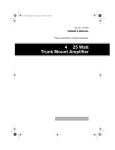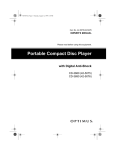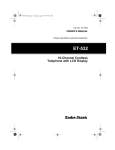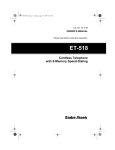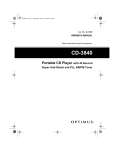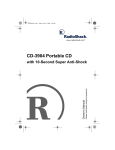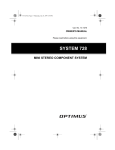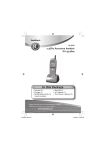Download Radio Shack CD-3445 Owner`s manual
Transcript
42-5056.fm Page 1 Thursday, August 12, 1999 9:25 AM Cat. No. 42-5056 OWNER’S MANUAL Please read before using this equipment. CD-3445 Portable Compact Disc Player 42-5056.fm Page 2 Thursday, August 12, 1999 9:25 AM FEATURES Your Optimus CD-3445 Portable Compact Disc Player uses the latest digital audio technology to give you clean, crisp compact disc sound. You can connect the CD player to your home audio system with the supplied connection cable or connect a pair of stereo headphones to the CD player for private listening. The CD-3445's advanced technology makes it simple to operate. You can power your CD player from two AA alkaline or rechargeable batteries, or from standard AC power or your vehicle’s battery power. The CD player’s features include: Automatic Search Music System — lets you rapidly skip forward or backward through a CD. Bass Boost — lets you enhance the bass frequencies when using headphones. Intro Scan — lets you play the first 10 seconds of each track on a CD. Random Play — lets you play the tracks on a CD in a random order. Repeat Play — lets you automatically repeat a single track, an entire CD, or a programmed sequence. Memory Function — lets you program up to 21 tracks on a CD to play in any order. Rechargeable Battery Adapter — lets you recharge nickel-cadmium rechargeable batteries while they are in the CD player's battery compartment. Important: You need a pair of stereo headphones or amplified speakers to use your CD-3445. Your local Radio Shack store carries a complete line of headphones and speakers. Be sure you read this Owner's Manual completely so you can take advantage of all the CD-3445's advanced features. For your records, we suggest you record the serial number of the CD player in the space provided. The serial number is on the CD player's bottom panel. Serial Number __________________ © 1995 Tandy Corporation. All Rights Reserved. Optimus and Radio Shack are registered trademarks used by Tandy Corporation. 2 42-5056.fm Page 3 Thursday, August 12, 1999 9:25 AM CONTENTS Choosing a Power Source .................................................................................. Using Batteries ................................................................................................ Installing Batteries .................................................................................... Charging Nickel-Cadmium Batteries ........................................................ Charging Tips ........................................................................................... Using AC Power .............................................................................................. Using Vehicle Battery Power ........................................................................... 4 4 4 5 6 6 7 Connections ......................................................................................................... Connecting Headphones ................................................................................ Listening Safely ........................................................................................ Traffic Safety ............................................................................................. Connecting Amplified Speakers ...................................................................... 8 8 8 9 9 Operation ............................................................................................................ Playing a CD ................................................................................................. Special Features ........................................................................................... Track Skipping/Searching ....................................................................... Intro Scan ............................................................................................... Random Play .......................................................................................... Repeat Playback .................................................................................... Storing a Programmed Sequence .......................................................... Checking/Editing a Programmed Sequence ........................................... CD Player Tips .............................................................................................. Caring For Compact Discs ............................................................................ 10 10 11 11 12 12 12 13 13 14 14 Care And Maintenance ...................................................................................... 15 FCC Information ............................................................................................ 16 Laser Safety .................................................................................................. 16 Specifications .................................................................................................... 17 3 42-5056.fm Page 4 Thursday, August 12, 1999 9:25 AM CHOOSING A POWER SOURCE You can power your CD player from: • Internal battery power (using two AA alkaline or rechargeable nickel-cadmium batteries, not supplied) 2. Insert two AA batteries into the battery compartment according to the polarity symbols (+ and –) in the compartment. • Standard AC power (using an optional AC adapter, not supplied) (illus) • Vehicle battery power (using an optional DC adapter, not supplied) USING BATTERIES You can power your CD player from two AA batteries. For the best results, we recommend alkaline batteries, such as Radio Shack Cat. No. 23-552/ 557. Or, you can use rechargeable nickel-cadmium batteries, such as Cat. No. 23-125, and charge them in the CD player with the supplied battery adapter. Installing Batteries 1. Slide off the battery compartment cover in the direction of the arrow. (illus) Notes: • Use only fresh batteries of the required size and type. • Never mix fresh and old, alkaline and nickel-cadmium batteries, or nickel-cadmium batteries of different capacities. • To help you remove the batteries later, place them across the ribbon. 3. Replace the cover. Notes: • Replace the batteries when BATT appears on the display, the sound distorts, or the volume weakens. • Always dispose of old batteries promptly and properly. • Never leave dead, old, or weak batteries in the CD player. They can leak chemicals and corrode or damage electronic circuits. 4 42-5056.fm Page 5 Thursday, August 12, 1999 9:25 AM • If you do not plan to use the CD player from battery power for a month or more, remove and store the batteries. They might leak chemicals and corrode or damage electronic circuits. Charging Nickel-Cadmium Batteries Nickel-cadmium batteries come fully discharged. You can charge the batteries while they are in the battery compartment using the supplied battery adapter and an optional AC adapter (such as Cat. No. 273-1663, not supplied), or you can use an optional external battery charger (such as Cat. No. 23-133, not supplied). Warning: Do not try to charge nonrechargeable batteries. They might get very hot and possibly explode. Follow these steps to recharge nickelcadmium batteries in the battery compartment. 2. Insert the battery adapter into the battery compartment according to the polarity symbols (+ and –) inside the compartment. 3. Plug the AC adapter’s barrel plug into the CD player’s DC 6V jack. Then plug the other end of the adapter into a standard AC outlet. (illus) Note: With the CD player turned off, it takes about 15 hours to charge fully discharged nickelcadmium batteries. 4. When the batteries are fully charged, unplug the AC adapter from the AC outlet. 1. Put two rechargeable batteries into the supplied battery adapter according to the polarity symbols (+ and –) on the adapter. (illus) 5 42-5056.fm Page 6 Thursday, August 12, 1999 9:25 AM Charging Tips • Fully discharge the batteries occasionally by playing the CD player until it no longer plays. Then fully recharge the batteries. This helps restore the batteries’ full charging capacity. • Avoid charging the batteries in a hot environment (higher than 113°F). Doing so can permanently reduce the batteries’ charging capacity. • Do not overcharge batteries. Overcharging can severely reduce the batteries’ useful life. Important: This CD player is capable of using nickel-cadmium batteries. At the end of the batteries’ useful life, they must be recycled or disposed of properly. Contact your local, county, or state hazardous waste management authorities for information on recycling or disposal programs in your area. Some options that might be available are municipal curb-side collection, drop-off boxes at retailers, recycling collection centers, and mail-back programs. USING AC POWER You can power your CD player with standard AC power using a 6-volt AC adapter such as Cat. No. 273-1663. Caution: The recommended AC adapter supplies regulated 6 volts and delivers at least 600 milliamps. Its center tip is set to positive, and its plug correctly fits the CD player’s DC 6V jack. Using an adapter that does not meet these specifications could seriously damage the CD player or the adapter. To connect to AC power, insert the AC adapter’s barrel plug into the CD player’s DC 6V jack, then plug the other end of the adapter into a standard AC outlet. (illus) Note: When you connect an AC adapter, the CD player automatically switches to external power, even if batteries are installed. 6 42-5056.fm Page 7 Thursday, August 12, 1999 9:25 AM USING VEHICLE BATTERY POWER 3. Plug the other end of the adapter into your vehicle’s cigarette-lighter socket. You can power your CD player from your vehicle’s battery power using a 6volt DC adapter such as Cat. No. 2701563. Caution: The recommended DC adapter supplies regulated 6 volts and delivers at least 600 milliamps. Its white adaptaplug correctly fits the CD player’s DC 6V jack and you can set its center tip to positive. Using an adapter that does not meet these specifications could seriously damage the CD player or the adapter. Follow these steps to connect your CD player to your vehicle’s battery power. (illus) Note: When you connect a DC adapter, the CD player automatically switches to external power, even if batteries are installed. 1. Insert the white adaptaplug into the adapter’s wire socket so TIP and + line up. 2. Insert the DC adapter’s barrel plug into the CD player’s DC 6V jack. 7 42-5056.fm Page 8 Thursday, August 12, 1999 9:25 AM CONNECTIONS You can listen to your CD-3445 by connecting stereo headphones to the CD player’s PHONES jack or by connecting amplified speakers or a home audio or autosound system to the LINE OUT jack using the supplied Y-adapter cable. CONNECTING HEADPHONES For private listening, plug a pair of stereo headphones with a 1/8-inch plug into the CD player’s PHONES jack. Notes: • The CD player’s PHONES jack is a high-level audio output, and its volume is controlled by the CD player’s VOLUME control. Use this jack with headphones or amplified speakers that do not have a volume control. • The CD player’s LINE OUT jack is a low-level audio output, and its volume is controlled by the volume control of the amplified speakers, home audio system, or autosound system. • Your local Radio Shack store carries a variety of headphones and amplified speakers. (illus) Listening Safely To protect your hearing, follow these guidelines when you use headphones. • Set the volume to the lowest setting before you begin listening. After you begin listening, adjust the volume to a comfortable level. • Do not listen at extremely high volume levels. Extended high-volume listening can lead to permanent hearing loss. • Once you set the volume, do not increase it. Over time, your ears adapt to the volume level, so a volume level that does not cause discomfort might still damage your hearing. 8 42-5056.fm Page 9 Thursday, August 12, 1999 9:25 AM Traffic Safety Do not wear headphones while operating a motor vehicle or riding a bicycle. This can create a traffic hazard and is illegal in some areas. Even though some headphones are designed to let you hear some outside sounds when listening at normal volume levels, they still present a traffic hazard. CONNECTING AMPLIFIED SPEAKERS (illus) To listen to your CD player through speakers, plug a pair of amplified speakers with a 1/8-inch plug into the CD player’s LINE OUT jack using either: • The supplied Y-adapter cable. • The amplified speakers’ built-in Ycable 9 42-5056.fm Page 10 Thursday, August 12, 1999 9:25 AM OPERATION Warning: This CD player has a wide dynamic range. If you turn up your amplifier’s volume too high during soft (low volume) parts of the music, you might damage your hearing when a sudden loud passage occurs. 3. Press OPEN and lift the disc compartment cover. OPEN appears on the display. (illus) PLAYING A CD Follow these steps to play a CD. 1. Set POWER to ON. 00 briefly appears on the display, then disc appears. 4. Carefully place the CD, label side up, over the disc compartment’s center hub. (illus) (illus) 2. Set VOLUME to the minimum level. 6. Press (Play/Pause). Track 1 begins to play while , 01, and the track’s elapsed playback time appear on the display. t t (illus) 5. Gently press down on the CD until it clicks in place, then close the disc compartment cover. The display briefly shows 00 then the total number of tracks and the total playing time. (illus) 10 42-5056.fm Page 11 Thursday, August 12, 1999 9:25 AM 7. If you connected headphones to the CD player’s PHONES jack, adjust the CD player’s VOLUME control to set the desired volume level. If you connected amplified speakers or a home audio or autosound system to the CD player’s LINE OUT jack, adjust the volume controls on those units to set the desired volume level. 8. If you are using headphones, set BASS BOOST to ON to enhance bass frequencies. (illus) When the last track finishes playing, the CD player automatically stops. To stop playing the CD before it automatically stops, press n (Stop). The display shows the total number of tracks and the CD’s total playing time. SPECIAL FEATURES Track Skipping/Searching Use or (Skip/Search) to rapidly search forward or backward to locate a specific track or section of the CD. (illus) To skip forward through the tracks, press . To skip backward, press . The current track number appears on the display. To search within a track, press and hold either button. You hear the track play rapidly and at a lower volume. Release the button to resume normal play. (illus) 11 42-5056.fm Page 12 Thursday, August 12, 1999 9:25 AM Intro Scan Repeat Playback Press INTRO SCAN to play the first 10 seconds of each track on the CD. INTRO, the track number, and the elapsed time appear on the display. Your CD player can repeat: • A single track • The entire CD • A programmed sequence • Randomly selected tracks (illus) If you hear a track you want to listen to, press INTRO/SCAN again. INTRO disappears from the display, and normal playback resumes. To cancel intro/scan play, press n (Stop). Random Play To play the tracks on a CD in random order, press RANDOM, then PLAY . RANDOM appears on the display, and the CD player randomly plays all the tracks once, then stops. (illus) To repeat a single track, while your desired track is playing, press REPEAT. REPEAT 1 appears on the display, and the track plays repeatedly. (illus) To repeat an entire CD, press REPEAT until REPEAT ALL appears on the display. When the CD player reaches the end of the CD, it returns to the first track and replays all of the tracks. To repeat all tracks randomly, while RANDOM appears on the display, press REPEAT until REPEAT ALL appears on the display. All tracks on the CD play repeatedly in a random order. To repeat a programmed sequence, after you program a sequence (see “Storing a Programmed Sequence”), press REPEAT until REPEAT ALL appears. After the last track finishes, the programmed tracks play repeatedly. To cancel random play, press RANDOM again. 12 To cancel repeat play, press n (Stop). 42-5056.fm Page 13 Thursday, August 12, 1999 9:25 AM You can program up to 21 tracks on a CD to play in any order you choose. You can program the same track to play more than once. 1. Press MEMORY. P:01 (the first memory location) appears. or Note: You can use either to move to another track in the programmed sequence. 6. To play the tracks in memory again, press MEMORY, then press (Play/Pause). t Storing a Programmed Sequence To stop playback, press n (Stop). To clear the memory sequence, press STOP, then press OPEN. (illus) 2. Press either or to find the track number you want to store. Checking/Editing a Programmed Sequence You can check and change any of the stored tracks in your programmed sequence. 1. Press MEMORY. The memory location and the track stored in it appear on the display. Notes: (illus) 3. Press MEMORY again. The track is stored in memory. 4. Repeat Steps 2 and 3 to store more tracks. t 5. Press (Play/Pause). Playback starts with the first track you stored and stops after the last track you stored. • Repeatedly press MEMORY to see the next stored track. • When you store less than 21 tracks, if you continue to press MEMORY after the last stored track appears, the display returns to 00. • When you store 21 tracks, if you continue to press MEMORY after P:21 appears on the display, the display returns to 01. 13 42-5056.fm Page 14 Thursday, August 12, 1999 9:25 AM 2. When the track you want to change appears on the display, press either or to find the track number you want to replace it with. (illus) 3. Press MEMORY again. The track is stored in memory. 4. Repeat Steps 2 and 3 to change more tracks. CD PLAYER TIPS • CDs that can be played on this player have this mark on them: LOGO • If you move the player from a very cold room to a warmer one, moisture can condense on the pickup lens, preventing proper disc play. If this happens, wait 30 minutes before resuming play. • Do not place foreign objects in the disc tray. This can damage the drive mechanism. 14 CARING FOR COMPACT DISCS Even though CDs are very durable, treat them with care. • Do not write on either side of a CD, particularly the non-label side. (Signals are read from the non-label side.) • Do not store CDs in high-temperature, high-humidity locations. The CDs might warp. • Keep the CD dry. A water drop can act as a lens and affect the laser beam’s focus. • Always keep the CD in its protective case or sleeve when it is not in use. • Always handle a CD by the edges to avoid fingerprints or scratches on the playing surface which can prevent the laser beam from correctly reading the digital information or create a “skipping” sound. • To remove fingerprints and clean the CD surface, use a CD cleaner kit (such as Cat. No. 42-226). • To repair scratches on the CD surface, use a CD scratch repair kit (such as “Scratch ’n Fix”, Cat. No. 42-127). 42-5056.fm Page 15 Thursday, August 12, 1999 9:25 AM CARE AND MAINTENANCE Your CD-3445 Portable Compact Disc Player is an example of superior design and craftsmanship. The following suggestions will help you care for the CD player so you can enjoy it for years. Keep the CD player dry. If it gets wet, wipe it dry immediately. Liquids might contain minerals that can corrode the electronic circuits. Handle the CD player gently and carefully. Dropping it can damage the circuit board and case, and can cause the player to work improperly. Use and store the CD player only in normal temperature environments. Temperature extremes can shorten the life of electronic devices, damage batteries and distort or melt plastic parts. Keep the CD player away from dust and dirt, which can cause premature wear of parts. CLEANER Wipe the CD player with a damp cloth occasionally to keep it looking new. Do not use harsh chemicals, cleaning solvents, or strong detergents to clean the CD player. Use only fresh batteries of the required size and type. Always remove old or weak batteries. They can leak chemicals that destroy electronic circuits. Modifying or tampering with the CD player’s internal components can cause a malfunction and might invalidate the CD player’s warranty and void your FCC authorization to operate it. If your CD player is not performing as it should, take it to your local Radio Shack store for assistance. 15 42-5056.fm Page 16 Thursday, August 12, 1999 9:25 AM FCC INFORMATION LASER SAFETY This equipment complies with the limits for a Class B digital device as specified in Part 15 of FCC Rules. These limits provide reasonable protection against radio and TV interference in a residential area. However, your equipment might cause TV or radio interference even when it is operating properly. To eliminate interference, you can try one or more of the following corrective measures: This unit employs a laser light beam. Only a qualified service person should remove the cover or attempt to service this device, due to possible eye injury. • Increase the distance between the equipment and the radio or TV. • Use outlets on different electrical circuits for the equipment and the radio or TV. Consult your local Radio Shack store or an experienced radio/TV technician if the problem still exists. 16 Warning: The use of controls or adjustments, or the performance of procedures other than specified herein, can result in hazardous exposure to laser light. 42-5056.fm Page 17 Thursday, August 12, 1999 9:25 AM SPECIFICATIONS Format ..............................................................Compact Disc, Digital Audio System Pickup..................................................................................3-Beam, Semiconductor Laser Decoding (D/A) .............................................................................. 1 Bit Linear Frequency Response ........................................................... 20 Hz to 20 kHz, ±3 dB Total Harmonic Distortion ...................................................Less Than 0.02%, 1 kHZ Signal-to Noise Ratio (A-Weighted).............................................. Better Than 85 dB Wow & Flutter. ..................................................................Below Measurement Limit Power Requirement.................................................. Internal 3VDC (2 AA Batteries) or, External 6VDC (AC adapter, Cat. No. 273-1663, or DC adapter, Cat. No. 270-1563) Power Consumption ...................................................................................... 2 Watts Dimensions (HWD) .................................................................11/8 ¥ 51/8 ¥ 61/8 inches (27 ¥ 130 ¥ 154 mm) Weight .............................................................................................. 10.6 oz. (300 g) Included Accessories..................................Y-Cable, Rechargeable Battery Adapter Specifications are typical; individual units might vary. Specifications are subject to change and improvement without notice. 17 42-5056.fm Page 18 Thursday, August 12, 1999 9:25 AM NOTES 18 42-5056.fm Page 19 Thursday, August 12, 1999 9:25 AM 19 42-5056.fm Page 20 Thursday, August 12, 1999 9:25 AM RADIO SHACK LIMITED WARRANTY This product is warranted against defects for 90 days from date of purchase from Radio Shack company-owned stores and authorized Radio Shack franchisees and dealers. Within this period, we will repair it without charge for parts and labor. Simply bring your Radio Shack sales slip as proof of purchase date to any Radio Shack store. Warranty does not cover transportation costs. Nor does it cover a product subjected to misuse or accidental damage. EXCEPT AS PROVIDED HEREIN, RADIO SHACK MAKES NO EXPRESS WARRANTIES AND ANY IMPLIED WARRANTIES ARE LIMITED IN DURATION TO THE DURATION OF THE WRITTEN LIMITED WARRANTIES CONTAINED HEREIN. Some states do not permit limitation or exclusion of implied warranties; therefore, the aforesaid limitation(s) or exclusion(s) may not apply to the purchaser. This warranty gives you specific legal rights and you may also have other rights which vary from state to state. We Service What We Sell 9/94 RADIO SHACK A Division of Tandy Corporation Fort Worth, Texas 76102 7A5 Printed in Hong Kong





















